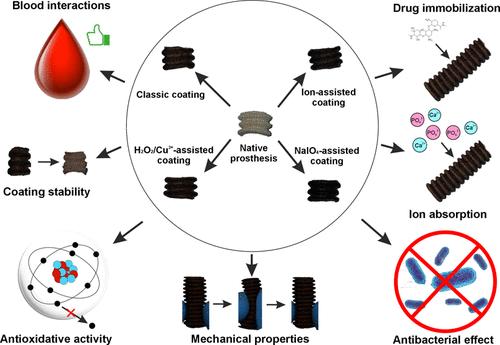当前位置:
X-MOL 学术
›
ACS Appl. Mater. Interfaces
›
论文详情
Our official English website, www.x-mol.net, welcomes your
feedback! (Note: you will need to create a separate account there.)
Comparison of the Impact of NaIO4-Accelerated, Cu2+/H2O2-Accelerated, and Novel Ion-Accelerated Methods of Poly(l-DOPA) Coating on Collagen-Sealed Vascular Prostheses: Strengths and Weaknesses
ACS Applied Materials & Interfaces ( IF 8.3 ) Pub Date : 2024-07-23 , DOI: 10.1021/acsami.4c05979 Michał Fornal 1 , Agnieszka Krawczyńska 2 , Anna Belcarz 1
ACS Applied Materials & Interfaces ( IF 8.3 ) Pub Date : 2024-07-23 , DOI: 10.1021/acsami.4c05979 Michał Fornal 1 , Agnieszka Krawczyńska 2 , Anna Belcarz 1
Affiliation

|
Sensitive biomaterials subjected to surface modification require delicate methods to preserve their structures and key properties. These include collagen-sealed polyester vascular prostheses. For their functionalization, coating with polycatecholamines (PCAs) can be used. PCAs change some important biological properties of biomaterials, e.g., hydrophilicity, bioactivity, antibacterial activity, and drug binding. The coating process can be stimulated by oxidants, organic solvents, or process conditions. However, these factors may change the properties of the PCA layer and the matrix itself. In this work, collagen-sealed vascular grafts were functionalized with a poly(l-DOPA) (PLD) layer using novel seawater-inspired ion combination as an accelerator, compared to the sodium periodate, Cu2+/H2O2 mixture, and accelerator-free reference methods. Then, poly(l-DOPA) was used as the interface for antibiotic binding. The coated prostheses were characterized (SEM, FIB-SEM, FTIR, UV/vis), and their important functional parameters (mechanical, antioxidant, hemolytic, and prothrombotic properties, bioactivity, stability in human blood and simulated body fluid (SBF), antibiotic binding, release, and antibacterial activity) were compared. It was found that although sodium periodate increased the strength and drug-binding capacity of the prosthesis, it also increased the blood hemolysis risk. Cu2+/H2O2 destabilized the mechanical properties of the coating and the graft. The seawater-inspired ion-accelerated method was efficient, stable, and matrix- and human blood-friendly, and it stimulated hydroxyapatite formation on the prosthesis surface. The results lead to the conclusion that selection of the PCA formation accelerator should be based on a careful analysis of the biological properties of medical devices. They also suggest that the ion-accelerated method of PLD coating on medical devices may be highly effective and safer than the oxidant-accelerated coating method.
中文翻译:

NaIO4 加速、Cu2+/H2O2 加速和新型离子加速聚 (l-DOPA) 涂层方法对胶原密封血管假体的影响比较:优点和缺点
进行表面改性的敏感生物材料需要采用精细的方法来保留其结构和关键特性。其中包括胶原蛋白密封聚酯血管假体。对于其功能化,可以使用聚儿茶酚胺 (PCA) 涂层。 PCA改变了生物材料的一些重要的生物学特性,例如亲水性、生物活性、抗菌活性和药物结合。涂层过程可以通过氧化剂、有机溶剂或工艺条件来刺激。然而,这些因素可能会改变 PCA 层和矩阵本身的属性。在这项工作中,与高碘酸钠、Cu 2+ /H 2 O 2混合物相比,使用新型海水启发的离子组合作为加速剂,用聚( l -DOPA)(PLD)层对胶原密封的血管移植物进行功能化,和无加速器参考方法。然后,聚( l -DOPA)用作抗生素结合的界面。对涂层假体进行了表征(SEM、FIB-SEM、FTIR、UV/vis)及其重要功能参数(机械、抗氧化、溶血和促血栓特性、生物活性、人体血液和模拟体液 (SBF) 中的稳定性、抗生素结合、释放和抗菌活性)进行了比较。结果发现,高碘酸钠虽然增加了假体的强度和药物结合能力,但也增加了血液溶血风险。 Cu 2+ /H 2 O 2使涂层和接枝物的机械性能不稳定。受海水启发的离子加速方法高效、稳定、对基质和人体血液友好,并且刺激假体表面羟基磷灰石的形成。 结果得出这样的结论:PCA 形成加速器的选择应基于对医疗器械生物特性的仔细分析。他们还表明,医疗器械上 PLD 涂层的离子加速方法可能比氧化剂加速涂层方法更有效且更安全。
更新日期:2024-07-23
中文翻译:

NaIO4 加速、Cu2+/H2O2 加速和新型离子加速聚 (l-DOPA) 涂层方法对胶原密封血管假体的影响比较:优点和缺点
进行表面改性的敏感生物材料需要采用精细的方法来保留其结构和关键特性。其中包括胶原蛋白密封聚酯血管假体。对于其功能化,可以使用聚儿茶酚胺 (PCA) 涂层。 PCA改变了生物材料的一些重要的生物学特性,例如亲水性、生物活性、抗菌活性和药物结合。涂层过程可以通过氧化剂、有机溶剂或工艺条件来刺激。然而,这些因素可能会改变 PCA 层和矩阵本身的属性。在这项工作中,与高碘酸钠、Cu 2+ /H 2 O 2混合物相比,使用新型海水启发的离子组合作为加速剂,用聚( l -DOPA)(PLD)层对胶原密封的血管移植物进行功能化,和无加速器参考方法。然后,聚( l -DOPA)用作抗生素结合的界面。对涂层假体进行了表征(SEM、FIB-SEM、FTIR、UV/vis)及其重要功能参数(机械、抗氧化、溶血和促血栓特性、生物活性、人体血液和模拟体液 (SBF) 中的稳定性、抗生素结合、释放和抗菌活性)进行了比较。结果发现,高碘酸钠虽然增加了假体的强度和药物结合能力,但也增加了血液溶血风险。 Cu 2+ /H 2 O 2使涂层和接枝物的机械性能不稳定。受海水启发的离子加速方法高效、稳定、对基质和人体血液友好,并且刺激假体表面羟基磷灰石的形成。 结果得出这样的结论:PCA 形成加速器的选择应基于对医疗器械生物特性的仔细分析。他们还表明,医疗器械上 PLD 涂层的离子加速方法可能比氧化剂加速涂层方法更有效且更安全。











































 京公网安备 11010802027423号
京公网安备 11010802027423号